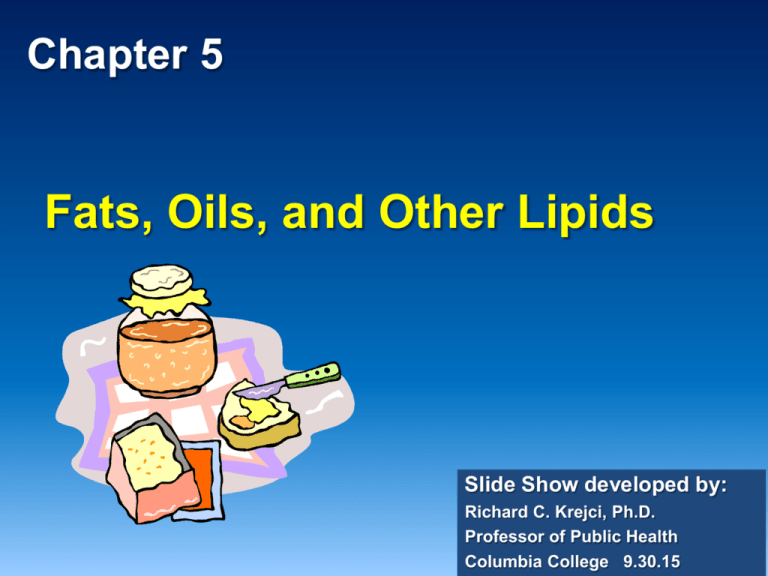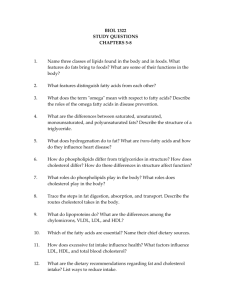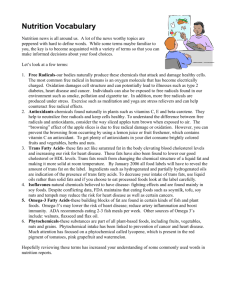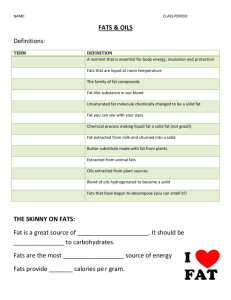
Chapter 5
Fats, Oils, and Other Lipids
Slide Show developed by:
Richard C. Krejci, Ph.D.
Professor of Public Health
Columbia College 9.30.15
Objectives for Chapter 5
1. Describe the three classifications of lipids.
2. Explain the differences in the structure of triglycerides,
phospholipids, and cholesterol.
3. Describe how fat is digested and absorbed in the body.
4. Explain how fat is transported in the blood.
5. Describe the functions of fat in the body.
Objectives for Chapter 5
6. Define the dietary recommendations for total fat, the
essential fatty acids, cholesterol, and trans fat.
7. Identify the major food sources of the different types of
fats, including the essential fatty acids, saturated fats, and
trans fats.
8. Compare the different fat substitutes currently used in
food products.
9. Describe the development of atherosclerosis, including its
role in the risk of heart disease.
10. Explain how lifestyle factors can affect the risk for heart
disease.
What Are Fats and Why Do You Need
Them?
Lipids: category of compounds containing carbon,
hydrogen, and oxygen that are hydrophobic (insoluble in
water)
Fat is the common name for just one type of lipid, known as
a triglyceride
Fats serve multiple functions in foods:
1. Give flaky texture to baked goods
2. Make meats tender
3. Provide flavor and aromas
4. Contribute to satiety
What Are Fats and Why Do You Need
Them?
Fats and other lipids perform important functions in
the body:
1. Energy storage
2. Insulation
3. Transport of proteins in blood
4. Cell membrane structure
Three types of lipids found in foods and in your body:
Triglycerides (fats), phospholipids, and sterols
Basic unit of triglycerides and phospholipids = fatty acids
Structure (2 parts) of a Fatty Acid
Acid
Group
Chain of Hydrogen and
Carbon Atoms
Figure 5.1
Fatty Acids Are Found in Triglycerides and
Phospholipids
Fatty acids: chain of carbon and hydrogen atoms
with acid group (COOH at one end)
Over 20 different fatty acids
Can vary by:
1. length of chain
2. whether carbons have double or single bonds
between them
3. total number of double bonds
Saturated vs. Unsaturated Fatty Acids
video
Figure 5.2
Fatty Acids Vary in Length and Structure
Saturated fatty acids: all carbons bonded to hydrogen
Example: stearic acid, 18 carbons, solid at room temperature
Unsaturated fatty acids: one or more double bond
between carbons (less saturated with hydrogen)
More liquid at room temperature
Monounsaturated fatty acids: one double bond
Example: Oleic acid, 18 carbons (olive oil)
Polyunsaturated fatty acids: more than one double
bond
Example: essential fatty acids linoleic and alpha-linolenic acids
(soybean oil)
Saturated and Unsaturated Fatty Acids
Help Shape Foods
Figure 5.3
Sources of Fats
Animal (saturated)
Exception is coconut or palm oil
H H H H H OH
ا
ا
ا
ا
ا
ا
H - C - C - C - C - C - C - Glyceride
ا
ا
ا
ا
H H H H H
Vegetable (unsaturated)
Poly-unsaturated
Mono-unsaturated
Can be hydrogenated
into “trans fatty acids”
H H H H H H H H OH
ا
ا
ا
ا
ا
ا
ا
ا
ا
H - C - C - C - C = C - C = C - C - C - Glyceride
ا
ا
ا
ا
H H
H
H
Double Bonds
Triglycerides Contain Three Fatty Acid
Chains
Triglyceride: three fatty acids connected to
glycerol “backbone”
Most common lipid found in foods and body
Referred to as fats
Saturated fats have mostly saturated fatty acids
Unsaturated fats have mostly unsaturated fatty
acids
Structure of a Triglyceride
Figure 5.4
Phospholipids Contain Phosphate
Phospholipids: have glycerol backbone but two
fatty acids and a phosphorus group
Phosphorus containing head is hydrophilic
Fatty acid tail is hydrophobic
Cell membranes made of phospholipid bilayer
Major phospholipid in cell membrane is lecithin
Lecithin used as emulsifier in foods such as
salad dressings to keep oils and water mixed
together
Keeping a Salad Dressing Blended
Figure 5.7
Structure of a Phospholipid
Figure 5.5
Phospholipids’ Role in Cell Membranes
Figure 5.6
Sterols Have a Unique Ring Structure
Sterols are comprised mainly of four connecting
rings of carbon and hydrogen
Example: cholesterol
Important role in cell membrane structure
Precursor of important compounds in body
Not required in diet since body makes all
cholesterol that is needed
Structure of a Sterol
Figure 5.8
The Three Types of Lipids
Figure 5.9
Animation: Fats in Food
Animation: Lipid Absorption
What Happens to the Fat You Eat?
Mouth: chewing, lingual lipase
Stomach: gastric lipase: di-glyceride and one fatty
acid
Small intestine:
Bile acids: emulsify fat
Pancreatic lipase: two fatty acids and glycerol
Lecithin in bile packaged with monoglycerides and fatty
acids to create micelles for absorption
Short-chain fatty acids enter bloodstream and travel to
liver
Long-chain fatty acids enter lymph and need transport
carriers
Digesting and Absorbing Fat
Figure 5.10
Animation: Fat Digestion
What Happens to the Fat You Eat?
Lipoproteins transport fat through the lymph and
blood
Chylomicrons: carry digested fat through lymph into
bloodstream
Very low-density lipoproteins (VLDL): deliver fat made
in liver to cells
Low-density lipoproteins (LDL, “bad” cholesterol):
deposit cholesterol on walls of arteries
High-density lipoproteins (HDL, “good” cholesterol):
remove cholesterol from body and deliver to liver for
excretion
Lipoproteins & Atherosclerosis
Video
Chylomicron
Figure 5.11
Lipoproteins
Bad
Guy
Bad
Guy
Good
Guy
Figure 5.12
Roles of Lipoproteins
Figure 5.13
How Does Your Body Use Fat and
Cholesterol?
Fat
An energy-dense source of fuel: 9 calories per gram
Glucagon also stimulates release of fat from fat
cells to fuel the heart, liver, and skeletal muscle
Is needed for absorption of fat-soluble vitamins A, D,
E, K, and carotenoids
Insulates body to maintain body temperature
Cushions bones, organs, nerves
How Does Your Body Use Fat and
Cholesterol?
Two polyunsaturated fatty acids, linoleic acid (an
omega-3 fatty acid) and alpha-linolenic acid (an
omega-6 fatty acid), are essential
Eicosanoids: hormone-like substances involved in
inflammation, blood clotting, blood pressure (learn more)
The essential fatty acids help maintain healthy skin
cells, nerves, and cell membranes
Eicosapentaenoic acid (EPA) and
docosahexaenoic acid (DHA): two omega-3 fatty
acids that are heart healthy
How Does Your Body Use Fat and
Cholesterol?
Cholesterol plays several vital roles:
Part of cell membranes
Serves as a precursor for:
1. Vitamin D
2. Bile acids
3. Sex hormones
Essential Fatty Acids
Figure 5.14
How Much Fat Do You Need Each Day?
You need to consume a specific percentage of your
daily calories from fat
AMDR of DRI: 20 to 35 percent of total daily calories
should come from fat
Remember that dietary fat has more than twice the
calories per gram (9/gram) of carbohydrates or protein
For heart health, you should consume less than 10
percent of your calories from saturated fats
How Much Fat Do You Need Each Day?
You need to consume a specific amount of
essential fatty acids daily
Between 5 and 10 percent of the total calories in your
diet should come from linoleic acid
Alpha-linolenic acid should make up 0.6 to 1.2 percent of
your total calories
How Much Fat Do You Need Each Day?
You should minimized saturated fat and trans
fat in your diet
Consuming too much saturated fat can lead to higher levels of
the “bad” LDL cholesterol carrier
Trans fats are created by food manufacturers through the
process of hydrogenation
Trans fats are just as worse for heart health than saturated fat
How Much Fat Do You Need Each Day?
You should minimize cholesterol in your diet
Your body makes all the cholesterol it needs so you
do not need to consume it in your diet
Healthy individuals over the age of 2 are advised
to limit their dietary cholesterol to less than
300 mg daily
Capping Your Fat Intake
Table 5.1
Creating Trans Fatty Acids
Figure 5.15
Trans fats
The majority of trans fat can be found in shortenings, stick
(or hard) margarine, cookies, crackers, snack foods, fried
foods (including fried fast food), doughnuts, pastries,
baked goods, and other processed foods made with or
fried in partially hydrogenated oils.
Some trans fat is found naturally in small amounts in
various meat and dairy products.
Major Food Sources of Trans Fat for
American Adults
Figure 5.16
Cholesterol Content in Common Foods
Highest per unit volume
Table 5.2
What Are the Best Food Sources of Fats?
Foods that contain unsaturated fats (both
monounsaturated and polyunsaturated fats) are
better for your health than foods high in saturated
fat, cholesterol, and/or trans fat
Unsaturated fats are abundant in vegetable oils as well as
soybeans, walnuts, peanut butter, flaxseeds, and wheat
germ
Vegetable oils, nuts, and flaxseeds are also good sources
of essential fatty acids
Food Sources of the Essential Fatty Acids
Figure 5.17
Where’s the Saturated Fat in Your Foods?
Figure 5.18
Composition of Various Fats
Figure 5.19
What Are Fat Substitutes and How Can
They Be Part of a Healthy Diet?
Fat substitutes are designed to provide all the
creamy properties of fat for fewer calories and total
fat grams
Because fat has more than double the calories per gram of
carbohydrates or protein, fat substitutes have the potential to reduce
calories from fat by more than 50 percent
Fat substitutes can be carbohydrate-, protein-, or fatbased
The majority are carbohydrate-based and use
plant polysaccharides
Sucrose + FFAs
Common Fat Substitutes
Table 5.3
What Is Heart Disease and What
Increases Your Risk?
Heart disease begins with a buildup in the arteries
Atherosclerosis: narrowing of arteries due to
buildup of plaque (hardened debris of cholesterolladen foam cells, platelets, calcium, cellular waste
products)
Thought to begin with injury to lining of arteries,
contributed by high blood pressure, high cholesterol
levels, and smoking
Increases chance of blood clots blocking the vessel,
causing heart attack or stroke
Atherosclerosis
Video
Figure 5.20
Risk Factors for Heart Disease
Table 5.5
What Is Heart Disease and What
Increases Your Risk?
Risk factors you can control:
Regular exercise can help lower LDL and raise HDL
cholesterol.
Losing excess weight and quitting smoking can help
increase HDL levels.
Other Potential Risk Factors: high levels of
homocysteine, Lp(a) protein, C-reactive protein
(sign of inflammation), presence of clamydia
pneumoniae
Syndrome X: group of risk factors, including insulin
resistance, that increase the risk of heart disease
Nutrition in the Real World: The
Traditional Mediterranean Diet
Traditional diet of Mediterranean region associated
with lower risk of heart disease and cancer
Very active lifestyle as well as long, relaxing family
meals, afternoon siestas, supportive community
Plant-based diet of whole grains, fruits, vegetables,
legumes, and nuts
With olive oil, low-fat dairy, water
Occasional fish, poultry,
eggs, meat, sweets, wine
The Traditional Healthy Mediterranean
Diet Pyramid
Misc 5.2
Animation: Lipoproteins
Tips to Control Cholesterol
Dr. Andrew Weil: Natural ways
to lower cholesterol
What Can You Do to Maintain Healthy
Blood Cholesterol Levels?
1. Minimize saturated fats, trans fats, cholesterol in diet
2. Eat more fish
3. Eat more plant foods
4. Load up on foods rich in antioxidants and phytochemicals
5. Get plenty of exercise and manage your weight
6. Moderate use of alcohol may reduce risk of heart disease
but some should avoid alcohol
7. The whole is greater than the sum of its parts
The Cholesterol Raising Effects of
Popular Foods
Table 5.7
Food Sources of Omega-3 Fatty Acids
Figure 5.21
Ways to Decrease Excess
LDL (Bad) Cholesterol
Table 5.8
Nutrition in the Real World: Mercury
and Fish
Methyl-mercury is a toxic chemical especially
harmful to the nervous systems of unborn children
Accumulates in larger fish with a longer life span
Examples: swordfish, shark, king mackerel, tilefish
FDA recommends women of childbearing age and
young children avoid these four types of fish
Pregnant women/women of childbearing age: up to
12 oz of other fish (variety) weekly
Canned albacore tuna has more mercury
than light tuna: 6 oz/week limit
The End
Slide Show developed by:
Richard C. Krejci, Ph.D.
Professor of Public Health
Columbia College
All Rights Reserved










